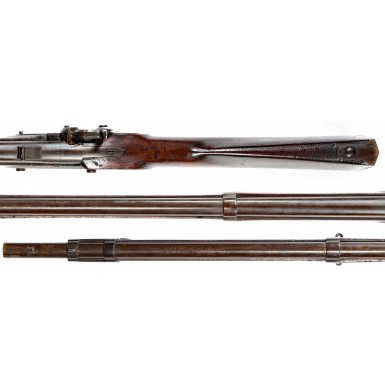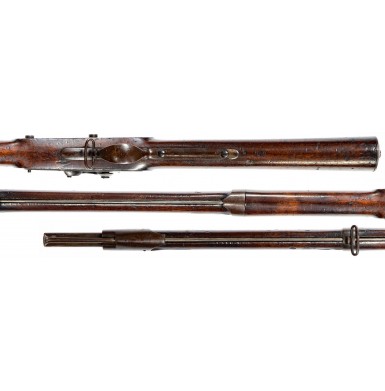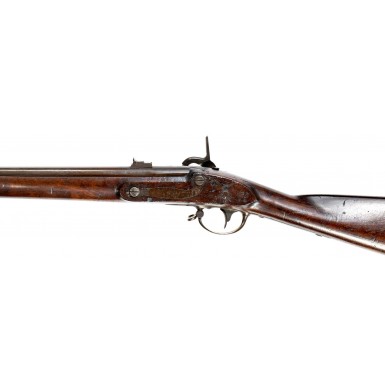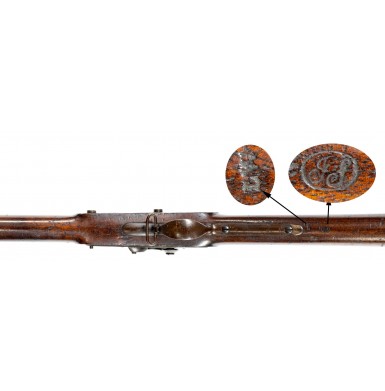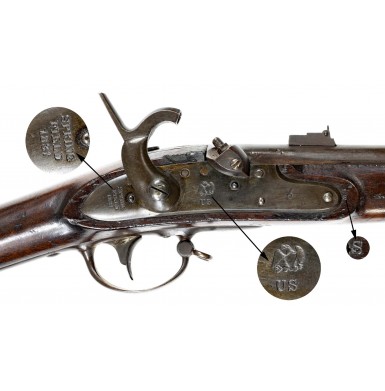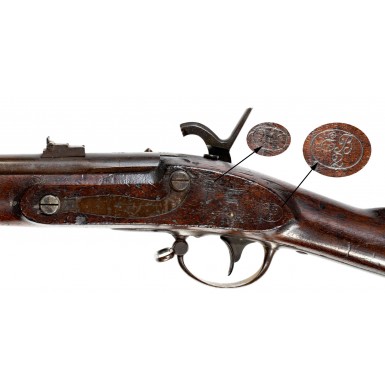National Armory Brown H&P Type I Alteration Rifled Musket - Quite Rare
- Product Code: FLA-C69
- Availability: Out Of Stock
-
$0.00
The coming of the American Civil War found the US Ordnance Department wholly unprepared to deal with the huge numbers of muskets that were required to arm the massive volunteer army that was organized in 1861 and early 1862. As a result, many troops were forced to enter the field carrying old flintlock muskets from the Mexican War era, and even earlier, which had been altered to percussion by a variety of systems. While some of the alterations had utilized new, chambered breech pieces, like the Remington-Maynard and Nippes-Maynard conversions, the majority were altered by the Belgian, or “Cone in Barrel”, system, which was not as strong and reliable. Experiments with rifling these “cone in barrel” altered muskets had less than satisfactory results, and the increased chamber pressures created by the use of expanding base ammunition often had catastrophic results. Sometimes the breeches of the “cone in barrel” altered muskets failed even though the guns remained in their original smoothbore configuration. Due to the pressing need to put muskets of any kind into the field, even if they were older obsolete guns, it was determined in July of 1862 that any remaining stores of US flintlock muskets that had not previously been altered to percussion, and all arsenal converted (i.e. “cone in barrel”) muskets that were not suitably safe for use (or had previously failed) were to be forwarded to Frankford Arsenal in Philadelphia. There, the guns were to be altered, or “re-altered” to percussion via the chambered breech system. This system involved cutting off the old breech of the barrels, and mating the old barrel with a newly made, solid breech piece with an integral percussion bolster that resembled the bolster of the US Model 1842 musket. In the case of arms that were “re-altered” the new breech was long enough to allow the removal of enough of the old barrel’s breech to get past the cone seat and threaded touchhole of the original alteration. However, the breeches used on new conversions of flintlocks to percussion were usually shorter, as less of the barrel had to be removed. Initially the plan included the rifling and sighting of these arms as well, as the chambered breeches had proved strong enough to handle the pressure created when firing expanding base, conical ammunition. The plan for rifling was soon abandoned, however, in the case of the older US Model 1816/22/28 series muskets, as the barrel walls were simply too thin to be safely rifled. However, the US Model 1835/40 muskets that were altered were rifled, as their barrels were the same thickness as the US M1842 muskets and were strong enough for the additional pressure created by the new ammunition. Frankford Arsenal received these arms during the summer of 1862 and let a series of contracts, 23 in all, to various arms makers, gunsmiths and machinists in the Philadelphia area to have the work performed. Between the fall of 1862 and the spring of 1863 some 35,023 muskets into stores Federal Arsenals from these contractors, who had performed the work. The majority of the contractors altered (or re-altered) between 100 and 200 guns, and a few altered as many as 900. Only five contractors delivered more than 1,000 muskets to the Ordnance Department, with the two largest contractors being Henry Leman of Lancaster, PA, who delivered 7,993 altered muskets between November of 1862 and May of 1863, and Hewes & Phillips of Newark, NJ, who delivered 12,127 muskets between December of 1862 and March of 1863. The Hewes & Phillips altered guns were almost all “re-alterations” of muskets previously altered at US arsenals, with only 1,937 of the guns being altered directly from flintlock. The firm charged $4.80 per musket to install the chambered breech and percussion hammer, add a US pattern 1858 3-leaf rear sight, install an iron front sight, and in the case of US M1835/40 muskets rifle the bores and modify the rammer tips for use with conical ammunition. The US M1816/22/28 muskets were left in their original smoothbore configuration and were not rifled. Hewes & Phillips struck their initials on the side of the large percussion bolster and sometimes on the top of the chambered breech, and the breeches were also dated either 1862 or 1863. To the collector of Civil War era infantry arms, it is somewhat incongruous to observe an obsolete US M1816 pattern musket, altered to percussion with a long-range rear sight, smooth bore and an 1863 dated chamber. Even though the gun was horribly obsolete, the need for infantry muskets was still so overwhelming during the 1st part of 1863 that these guns saw service in the field. By the summer of 1863, however, production of the current US M1861 by Springfield and numerous contractors had finally caught up with demand. This resulted in the cancellation of all outstanding contracts for foreign import arms and allowed the Ordnance Department to start systematically removing obsolete muskets from field service.
Hewes & Phillips had previously performed similar alteration work for the state of New Jersey, earlier in the war. These alterations, referred to by collectors as Type I H&P conversions, used the chambered breech of the later guns, but instead of a large flat bolster stamped with the H&P mark, a bolster with a clean out screw was utilized. Bolsters with two slightly different bolster shapes were used, with earliest guns using a rounder bolster with a convex face and the later bolster having a less round shape with flatter face into which the clean out screw was threaded. As a result, these rifled musket alterations were marked H&P on top of the breech area, typically across the seam of the barrel to breech joint. While the bores of the US contract alteration M1816 pattern muskets were not rifled, the New Jersey contract guns were rifled, with three broad grooves that were typical of arsenal world. The face of the button head ramrod was also relieved to accommodate the tapered nose of conical ammunition. During 1861 roughly 7,000 M1816 pattern muskets in storage in New Jersey were altered and upgraded by Hewes & Phillips of Newark, NJ. The firm charged $2.95 per musket. An additional 400-500 guns were similarly altered by Field & Horton for New Jersey in 1861. As with some of the Federal alterations, some of the New Jersey muskets were “re-alterations” of previously altered muskets.
Offered here is a VERY FINE example of a Hewes & Phillips Type I Conversion Musket, a rifled and sighted New Jersey contract alteration gun. The gun is a very scarce example that retains much of its arsenal applied brown finish and is a special example that reveals much of its history based upon its finish and markings. Like some of these H&P contract muskets, it is a re-alteration of a musket that had previously been altered by the cone-in-barrel system at the Watervliet Arsenal. This can be determined by the presence of the alphanumeric reassembly mark I 11 that is stamped into the comb of the stock, forward of the buttplate tang and into the bottom of the barrel. Watervliet altered slightly more than 73,000 muskets to percussion between 1849 and 1851. It can be assumed that this musket was one of the earlier alterations to percussion at Watervliet, because it retains much of its period National Armory Brown finish.
The US Model 1822 Musket (M1816 Type II) was produced with a lacquer browned finish of the barrel and iron furniture and a color case hardened lock, referred to as National Armory Brown. Early on in the alteration process it was discovered that the damage done to the browned finish caused by creating the percussion cone seat resulted in the barrel of the gun needing to be re-browned. Captain of Ordnance William Anderson Thornton, who spent much of his career dealing with the inspection and acceptance of contract arms, explained the problem to his superior Colonel Talcott of the Ordnance Department in a letter written from the Watertown Arsenal on October 12, 1849. The letter reads in part:
“I have the honor to report that in forming the Cone Seat in Percussion Muskets, the browning become so much defaced as to render it needful to re-brown the barrels; but to do this an make good work, it is will be necessary to brighten the entire barrel – And as the process of browning required experienced men – both in application and workmanship, and is also a dirty operation, I respectfully recommend that the alteration may be finished by polishing the parts & may have to brighten.”
It seems that for at least a short period of time, probably through late 1849 or early 1850, browned muskets that were percussion altered were subsequently re-browned after the alteration was completed. While no official order has been located relating to a change in policy, the dearth of extant percussion altered M1822 Muskets with browned finish suggests the re-browning process was quickly abandoned and the guns were simply polished to National Armory Bright, as Captain Thornton suggested. Those guns that were refinished received a much lighter color browning, more akin to the finish found on fine condition M1841 Mississippi Rifles or later production Harpers Ferry Hall Rifles. The original flintlock musket era browning was a significantly darker brown color, indicating that between the end of the National Armory Brown period circa 1832 and the mid-to-late 1830s, either the formula for the browning or the process for the browning (or both) changed. The gun was apparently in fine condition with nearly all of its brown finish when it was sent to Hewes & Phillips for alteration. Rather than strike the gun bright, Hewes & Phillips simply applied a rudimentary browned finish to the exposed metal surfaces of the new breech section and breech plug tang. This was not an uncommon practice among some of the Philadelphia and Lancaster, PA region gunmakers like Leman and JJ Henry, as they sometimes browned gun barrels only on the exposed surfaces while the barrel was in the stock. This musket retains most of the original Watervliet Arsenal applied light brown finish on the bottom of the barrel, with some of the finish polished off as part of the alteration process. The bottom of the H&P bolster is bright and was never browned, while the upper portion was. Like most H&P alterations, there are two sets of reassembly marks. The barrel and breech have the matching mating number 5, while the bottom of the barrel and the barrel channel of the stock have the matching mating number 3. The top seam of the breech and barrel are clearly marked H&P and the breech is dated 1861.
The New Jersey Contract H&P Alteration US Model 1822 (M1816 Type II) was originally manufactured at the Springfield Armory in 1831, during the next to last year of the National Armory Brown period and was “re-altered” to percussion by Hewes & Phillips in 1861. The lock of the gun is clearly marked in three vertical lines at the tail of the lock SPRING / FIELD / 183. Forward of the hammer there is the usual Springfield {SPREAD-WINGED EAGLE} over the letters US. As noted, the top of the barrel to breech seam is stamped H&P and the top of the breech is dated 1861. A raised P proof mark in a depressed circle is present on the breech, just in front of the added chambered breech. That is the only mark that remains from the original Springfield Armory applied proof marks. The expected N.J New Jersey ownership mark is present on the left of the barrel, near the breech, but is struck mostly below the stock line, making it nearly invisible when the gun is assembled. The counterpane of the stock is stamped with a pair of crisp cartouches. The forward cartouche is a lightly worn JN for Springfield Armory sub-inspector John Newbury. To the rear of the counterpane is a very crisp EB/2, reinspection rating cartouche, indicating that Elizur Bates rated the gun as “second class” for alteration to percussion. A fine final inspection cartouche is present in the toe line of the stock, behind the triggerguard. This is the script JS of John Stebbins, Assistant Master Armorer at Springfield Armory.
As is typical of the H&P alterations for New Jersey, the gun has been rifled with three broad grooves, the has been fitted with a US M1858 pattern 3-leaf rear sight that is mounted reversed, as it is found on nearly all examples of this alteration. H&P also installed a new iron front sight to replace the original brass blade on the front strap of the upper barrel band.
The musket is all original and correct in every way and remains in a very nice state of preservation. The metal is particularly crisp and well-marked, as detailed above. The barrel and iron mountings retain some nice original arsenal applied brown, with some loss due to flaking and wear. The browning and the exposed metal has developed a thickly oxidized brown patina that has blended almost seamlessly, making the gun appear to retain even more brown. The bottom of the barrel retains at least 80%+, if not more of the original arsenal applied browning with a lovely, light milk chocolate color. The color casehardened lock has a thickly oxidized patina that has left the lock with a darkly mottled bluish-brown color. The metal shows no pitting to speak of and is mostly smooth, showing only some very lightly scattered pinpricking and minor flecks of light surface oxidation and minor roughness. The rifled bore of the musket is in FINE condition as well. It retains strong rifling and is mostly bright, having been protected by a thick layer of old grease, much of which is still in the breech area. The bore should be aggressively cleaned to remove the grease should the new owner ever consider shooting the gun. There is some very light frosting and pinpricking in the bore, but some may be dirt and debris trapped by the remnants of the grease. The lock of the musket is mechanically excellent and functions perfectly on all positions. The original US 1858 pattern 3-leaf long-range rear sight is in place on the breech and is fully functional. The sight retains about 50%+ of its original blued finish, which has blended with a thickly oxidized brown patina. The original iron front sight, installed during the alteration process, is in place on the front strap of the upper barrel band. The original socket bayonet stud is in place near the muzzle of the musket as well and is stamped with the mating mark 24, with the “4” stamped sideways. Both original sling swivels remain with the musket, as does its original button head ramrod. The rod is full-length with good threads at its reverse end. The face of the rod has been appropriately recessed for use with elongated ball ammunition. The stock of the musket is in about FINE condition as well. It is full-length and solid with no breaks or repairs and shows fine wood to metal fit. The wood is crisp with sharped edges throughout and no indications of having been sanded. As noted, a fine re-inspection cartouche is present on the counterpane, with a weaker sub-inspection cartouche. The final inspection cartouche behind the triggerguard is fine as well. There is a tiny chipped sliver of wood missing along the reverse edge of the breech plug tang, but it is so minor that it is barely noticeable. As would be expected, the stock shows numerous scattered bumps, dings, bruises and mars that would be found on a military musket that was made before the Mexican American War and remained in service for over two decades.
Overall this is a really wonderful example of a National Armory Brown Hewes & Phillips Type I Alteration Rifled Musket. The gun is 100% complete and correct with crisp markings and a fine bore. This would also be a great addition to any collection of high condition and scarce variant Civil War muskets. While New Jersey contract rifled & sighted M1816 pattern alterations are relatively available, guns in this condition with most of their original arsenal browned finish are exceptionally scarce and are rarely encountered for sale.
ON HOLD / LAYAWAY
Tags: National, Armory, Brown, H&P, Type, I, Alteration, Rifled, Musket, Quite, Rare







